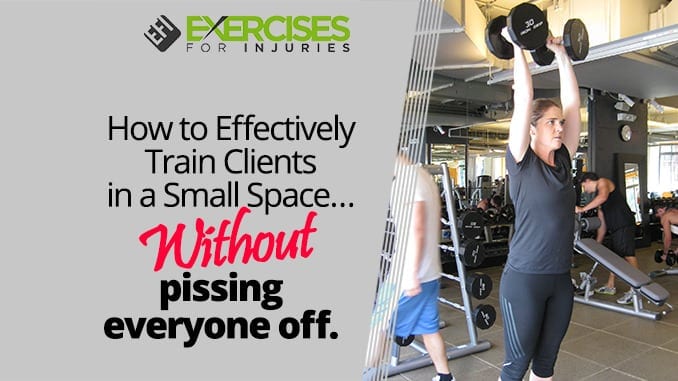
Training clients back-to-back means that they both have their training station, but they begin their training at the same time and finish their training simultaneously.
The clock strikes chaos. You have been training clients all afternoon, roaming free and dominating the gym space.
As the after-work crowd charges towards the squat rack, your heart rate skyrockets.
It seems like the room just got a whole lot smaller.
Embrace the Mayhem
As a private trainer in New York, I simply have to work in close quarters to get the job done. You have to roll with it, or your business will fail.
However, how to train effectively in a small space is one of the most overlooked considerations for trainers.
To successfully train clients in small gyms, you must understand the unspoken rules of working with limited space.
5 Tips for Train Your Clients with Limited Space – AND get results.
1. Be Prepared AND Flexible
Prepare for the worst. Hope for the best.
Prepare for every client training session. However, it must be a draft game plan. This is one big mistake I see trainers always make, who feel they must follow exactly what the sheet says. Let’s face it; nothing goes exactly to plan, even your workouts.
Referring to paper notes throughout the session is amateurish. This is why it’s essential to have an excellent knowledge base of exercise progressions and substitutions in your HEAD. Think about the movement patterns you want to focus on and plan your exercise selection around this – then adjust it according to the space and equipment available.
As a backup plan, you must have a series of efficient go-to movements that you can add to any program anytime the space becomes too crowded. For example, a Bodyweight Mash-Up is one of my favorite go-to metabolic sequences that can be modified for most clients. Depending on your situation and space constraints, you can do 2-3 rounds.
- Prisoner Squats – 30 seconds
- Walkout to push-ups – 30 seconds
- Alternating reverse lunges – 30 seconds
- Mountain climbers – 30 seconds
- Jumping jacks – 30 seconds
2. Consider Other Trainers and Your Client
Awareness of other trainers sharing the space with your client is crucial in practical training in a small gym. Anticipate how much room your client will need to perform an exercise so you don’t interfere with anyone else and avoid injury.
Courteous gestures go a long way. If you are unsure if a trainer is using a piece of equipment, just ask. This goes for cleaning up after yourself, too – there is no room for equipment to be left lying around.
If you are new to working in a particular space, respect the trainers already working there. Too often, I’ve seen meatheads stroll onto the floor, thinking they own it and pissing everyone off. Don’t be that guy.
Respect your client. You want your client to trust you, feel comfortable, and never be threatened. Some clients will feel self-conscious, and specific exercises will not be appropriate. I never get my clients to do an activity I wouldn’t feel comfortable doing myself.
And listen, sitting on a bench and texting while your client works hard is unacceptable. This is not only lazy, but you are wasting precious space.
3. Hold Your Space (Get Physical if You Have To)
Spreading yourself out all over the gym is fine IF it’s quiet.
When the space is crowded, hold your area. This is not the time to set up an excellent Tough Mudder obstacle course. Save it for another day.
Like I said, instead of floating all over the gym, keep your client in one area and bring the equipment you need to the client BEFORE you start. Chunk exercises together that flow smoothly. You know the weight your client can lift, so be ready.
Avoid dangerous positioning. It’s unnecessary to get out chalk and draw the line (even though I’ve seriously considered doing this). Remember, cutting in front of people and invading other people’s personal space is inappropriate. As the trainer, you direct and control where you want your client to stand or lie down. Be confident in your manner – and your client will follow your lead.
4. Be One Step Ahead
Always think about the NEXT exercise your client will do during the workout. Plan and move accordingly.
Anticipate how your client is feeling, and be responsive to their cues. An example is if they develop unusual soreness or tightness during a session. Again, you need to adapt the workout to their needs. Never fish for the next exercise; your client will notice and question your ability.
5. Focus on the Flow
Perfecting the Flow is the secret to an effective workout in a small space. I’m not going all yoga on you, but a confident flow involves transitioning and progressing one movement to the next. Maintaining this workout flow will make it appear seamless and well planned. Utilizing your equipment will ensure smooth transitions and enhance the session’s effectiveness.
You want to start with dynamic moves to increase the range of motion and prepare for the movements you will train. Avoid starting with the wrong plyometric moves that you might see on certain home workout DVDs. This will empty the tank in the first five minutes, which overall is not beneficial, and your client will hate you.
Dragging your client all over the gym and resting too much between sets disrupts the Flow, as does meaningless chit-chat. I’m not anti-chatting, but there is a time and place for it. Train hard, then chat.
Some of these points may seem pervasive to you; however, you would be surprised by the number of folks who completely disregard others in small gym spaces. This is frustrating as a trainer and unfair to clients who pay top dollar for your expertise.
It may seem daunting to be confined to a limited workout space, but being creative will challenge your client, get results and keep them coming back for more.
31 NEW Fat Loss Accelerators
I have put together 31 NEW Fat Loss Accelerators you can simply plug into your client training sessions now, which can work in any small space and require minimal equipment. This means you don’t have to sit down and combine go-to metabolic sequences when the room is crowded. I have done the work for you.
Click here to check out my new Accelerators.
A happy, lifelong client gets what they want – results. While training in small spaces can be a headache, your workouts will be effective and successful if you keep these simple tips in mind.
Be awesome,
Kate Vidulich, BSc, ACSM HFS
Creator of Fat Loss Accelerators
P.S. – If you liked this post from Kate, you should check this one out Top 5 Fat Loss Workout Mistakes




